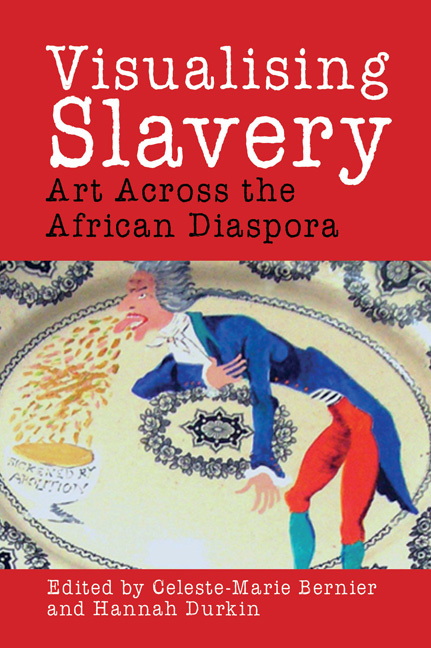Book contents
- Frontmatter
- Dedication
- Contents
- List of Illustrations
- Acknowledgements
- Introduction: ‘Inside the Invisible’: African Diasporic Artists Visualise Transatlantic Slavery
- Part I Slavery and Memory in Contemporary African Diasporic Art
- Part II Historical Iconography and Visualising Transatlantic Slavery
- Part III African Diasporic Monuments and Memorialisation
- Chapter 10 Siting the Circum-Atlantic: Nelson in a Bottle in Trafalgar Square
- Chapter 11 Art and Caribbean Slavery: Modern Visions of the 1763 Guyana Rebellion
- Chapter 12 ‘The Greatest Negro Monuments on Earth’: Richmond Barthé's Memorials to Toussaint Louverture and Jean-Jacques Dessalines
- Part IV Contemporary Legacies in African Diasporic Art
- Afterword: Against the Grain: Contingency and Found Objects
- Notes on Contributors
- Index
- Platesection
Chapter 10 - Siting the Circum-Atlantic: Nelson in a Bottle in Trafalgar Square
from Part III - African Diasporic Monuments and Memorialisation
- Frontmatter
- Dedication
- Contents
- List of Illustrations
- Acknowledgements
- Introduction: ‘Inside the Invisible’: African Diasporic Artists Visualise Transatlantic Slavery
- Part I Slavery and Memory in Contemporary African Diasporic Art
- Part II Historical Iconography and Visualising Transatlantic Slavery
- Part III African Diasporic Monuments and Memorialisation
- Chapter 10 Siting the Circum-Atlantic: Nelson in a Bottle in Trafalgar Square
- Chapter 11 Art and Caribbean Slavery: Modern Visions of the 1763 Guyana Rebellion
- Chapter 12 ‘The Greatest Negro Monuments on Earth’: Richmond Barthé's Memorials to Toussaint Louverture and Jean-Jacques Dessalines
- Part IV Contemporary Legacies in African Diasporic Art
- Afterword: Against the Grain: Contingency and Found Objects
- Notes on Contributors
- Index
- Platesection
Summary
In the semi-hysterical cacophony that greeted the death of Baroness Thatcher in 2013, an audible and persistent refrain was the call for a permanent memorial to the Iron Lady. The Evening Standard reported that Boris Johnson, the Mayor of London, had instructed staff to ‘explore potential sites in London for a statue’ to her, following calls for one to be placed ‘on the fourth plinth in Trafalgar Square’. Lord Tebbit suggested that ‘Nelson could keep an eye on her’, but former Mayor Ken Livingstone countered this with the claim that ‘The understanding is that the fourth plinth is being reserved for Queen Elizabeth II. That's why we had a rolling programme of temporary exhibits there’.
Taken as understood in this seemingly superficial exchange and report are (for my purposes here) three fundamental, naturalised – and therefore ideological – assumptions. First, the specifics of the site: the fourth plinth is taken to respond in some way to Nelson as the primary focus of the square, who can ‘keep an eye’ on the plinth (though he faces the opposite direction, south towards Parliament, on which he has traditionally been supposed to ‘keep an eye’). Second, that there is a stark difference in value between permanent memorials and temporary display: so, for Livingstone, the assumption is that the temporary exhibition programme is little more than a way of filling in time until the Queen pops her clogs, at which point, presumably, the art programme will come to an abrupt halt or will have to move elsewhere. And last, and perhaps most importantly – even though it is to state the blindingly obvious – it reminds us that memorialisation (and all that this term implies regarding the sanctioning of history and cultural memory) is, before anything else, a subject for politics.
This exchange also seems to have major implications concerning the significance of the fourth plinth and the series of artworks commissioned for it, making it a far more complex project than simply the official sponsoring of contemporary art. In this essay I want to consider these issues in relation to what is perhaps (so far, at least) the most celebrated – and in my view, certainly the finest – work completed for the fourth plinth series: Yinka Shonibare MBE's Nelson's Ship in a Bottle, unveiled on 24 May 2010.
- Type
- Chapter
- Information
- Visualising SlaveryArt Across the African Diaspora, pp. 155 - 167Publisher: Liverpool University PressPrint publication year: 2016



